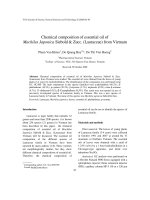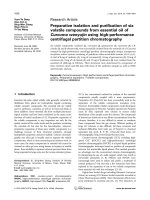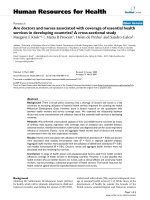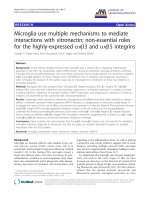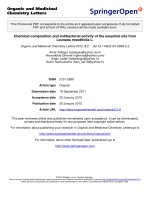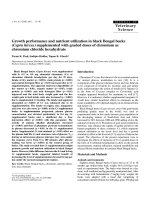Synbiotic yogurt supplemented with Ocimum sanctum essential oil
Bạn đang xem bản rút gọn của tài liệu. Xem và tải ngay bản đầy đủ của tài liệu tại đây (512.91 KB, 13 trang )
Int.J.Curr.Microbiol.App.Sci (2018) 7(3): 1250-1262
International Journal of Current Microbiology and Applied Sciences
ISSN: 2319-7706 Volume 7 Number 03 (2018)
Journal homepage:
Original Research Article
/>
Synbiotic Yogurt Supplemented with Ocimum sanctum Essential Oil
Santosh Anand1*, Manju Gaare2, Priyanka Saini1, Arun Beniwal1 and
Chand Ram Grover1
1
Bioremediation Research Laboratory, Dairy Microbiology Division, ICAR-National Dairy
Research Institute, Karnal-132001, Haryana, India
2
Department of Dairy and Food Microbiology, GN Patel College Dairy Science and Food
Technology, Sardarkrushinagar Dantiwada Agricultural University, Gujarat, India
*Corresponding author
ABSTRACT
Keywords
Yoghurt, Prebiotic,
Probiotic, Essential
oil, Symbiotic
Article Info
Accepted:
10 February 2018
Available Online:
10 March 2018
The present investigation was focused primarily to develop synbiotic herbal yoghurt
incorporating Ocimum sanctum essential oil (EO). Prebiotic was selected on the basis of
specific growth rate (µ) of cultures. EO concentration was optimized on the basis of its
compatibility of culture and sensory properties. Investigations on effect of prebiotics
(inulin and maltodextrin) on growth kinetics of probiotic cultures indicate that former
enhanced change in log count/ml and specific growth rate (µ) faster than maltodextrin at
3% level. Change in log count and specific growth rate were observed to the tune of 1.78
CFU/ml and 0.683 h 1 at 3% inulin in comparison to 1.42 CFU/ml and 0.545 h 1 of
maltodextrin at above level during incubation period in case of L. bulgaricus LB-2.
Almost similar trend was obtained in case of S. thermophilus ST-1 for both prebiotics.
Culture inoculum at rate of 1%and EO at concentration 0.5 µL/ml was found compatible
with yoghurt culture on the basis of sensory, physiological and microbiological quality.
The developed product was assessed for shelf life quality parameters upto 21 days. The
developed product was judged suitable for consumption with acceptable sensory attributes
and viable probiotic counts (108-109 cfu/ml) till 15 days of storage. The developed product
possesses antioxidative activity and phenol content of 763.8µM trolox equivalent/L and 7
mg GAE/100 ml respectively. Further research is needed by employing clinical trials to
substantiate in vitro data. As a value added synbiotic herbal product, it may have great
potential for commercialization.
Introduction
Dairy foods have been consumed since ages as
almost complete foods to meet body energy
requirements.
Dairy
foods
especially
fermented products are highly consumed by
people of all age groups and have been choice
of innovation to fulfil fluctuating needs of
consumers (Si et al., 2006; Ares et al., 2010).
Now a day‟s food habit focuses on foods
search with dual purposes, health benefits
beyond traditional nutrition and a hygienically
1250
Int.J.Curr.Microbiol.App.Sci (2018) 7(3): 1250-1262
safe food (Özer and Kirmaci, 2010). In
fermented dairy products addition of live
beneficial microorganisms and prebiotics,
which have potentials to modulate various
biological functions of host gained
tremendous momentum in last few decades.
They are termed as probiotics; “live
microorganisms which, when administered in
adequate amounts confers health benefits”
(FAO/WHO, 2002) whereas prebiotic is
defined as “a non-digestible food ingredient
that beneficially affects the host by selectively
stimulating the growth and/or activity of one
or a limited number of bacteria in the colon”
(Schrezenmeir and deVrese, 2001).
Prebiotics are non-digestible oligosaccharides
that support growth of probiotics specifically
includes inulin, maltodextrins FOS, GOS etc.
There are several documented health benefits
conferred in the host upon regular
consumption and has been popular subjects of
review (Marco et al., 2017; Anand et al.,
2016). Combining both as new approach,
potential synergy of prebiotics and probiotics
called „synbiotics‟ in functional food research
are used (Anand et al., 2017; Likotrifiti et al.,
2015). Synbiotics have reportedly enhanced
probiotics survivability during storage,
gastrointestinal transit as well as colonisation
on intestinal epithelial cells (Kolida and
Gibson, 2011). India is known for its ancient
civilisation and renowned for traditional
medicinal knowledge, „Ayurveda‟ unparallel
in the world for its minimum side effects as
compared to allopathic drugs. Historically,
people are aware of antimicrobial and health
beneficial potentials. Almost 70% of the
world‟s population and 85% population of
developing countries depend on traditional
knowledge of their health needs. Hygienic
awareness towards green consumerism, but
ineffective elimination of pathogens and
microbial spoilages leads to development and
use of alternate techniques such as
incorporation
of
naturally
derived
antimicrobial ingredients like essential oils
(EOs). They also have Generally Regarded as
Safe (GRAS) status and their broad spectrum
inhibiting action against both Gram-positive
and Gram negative microorganisms are
gaining attention for its applicability in food
and dairy products (Burt, 2004). Amongst
herbal treasure of India Tulsi (Ocimum
sanctum) has antimicrobial potentials against
food spoilage and pathogenic bacteria (Si et
al., 2006). Moreover, shift in consumers
towards foods with limited or no synthetic or
chemical preservatives gave momentum for
exploration
of
naturally
occurring
antimicrobials for food preservation and to
fight microbial resistance to chemical
preservatives (Sharma et al., 2014). Hence,
addition of herbal extracts or essential oils
could be an effective approach to meet
requirements and also health benefits (Burt
and Reinders, 2003; Burt, 2004). Besides
being effective natural antimicrobial EO also
known for various health benefits such as anticarcinogenic
and
anti-hypersensitivity
(Rodríguez et al., 2009). There are quite a few
reports available on utilisation of herbs or
essential oils in fermented dairy foods
(Mendoza-Yepes et al., 1997; Ayar, 2002;
Burt, 2004). Although, it is highly desirable
that probiotics and essential oil must be
compatible and confer health benefit without
any adverse effect on sensory attributes of
product. This report describes prebiotic
selection for probiotic starters, compatibility,
product preparation physico-chemical, and
sensory studies of synbiotic yoghurt with
essential oil.
Materials and Methods
Microorganisms
Putative
probiotic
yogurt
cultures
Lactobacillus
bulgaricus
Lb-2
and
Streptococcus thermophilus ST-1 (lab isolates
isolated from dairy products) were activated
1251
Int.J.Curr.Microbiol.App.Sci (2018) 7(3): 1250-1262
on M17 and MRS agar (Himedia Labs Ltd,
Mumbai, India) respectively by overnight
incubation at 37°C. Cultures were stored
below 7°C in litmus milk and revived once in
fortnight. All the bacterial cultures were also
activated and maintained in glycerol stocks at
-80±1°C containing 20% glycerol.
culture was calculated using the following
equation: µ= (lnX2 - lnX1) / ( t1 - t2), where X2
and X1 are the cell density at time t2and t1.
Mean doubling time (Td) was calculated as: Td
= ln2 / µ.
Milk, essential oil, prebiotics and chemicals
Fresh buffalo milk was collected from cattle
yard of National Dairy Research Institute,
Karnal, Haryana. Skim milk powder for
standardisation was from Modern Dairies Pvt.
Ltd. Karnal, India. Essential oil ( Ocimum
sanctum) was procured from Moksha
products, New Delhi. Inulin and maltodextrin
from Orafti Tienan, Belgium through S.A.
Pharmachem Pvt. Ltd. Mumbai, India and
stored at ambient temperature in dark place.
Other chemicals used in study were procured
from Merck® Chemicals.
Fresh buffalo milk upon standardisation (3.5%
fat; 13% MSNF; 6.9 pH) used for yogurt
preparation by following the method followed
by Raju and Pal (2009). Initially prebiotic was
added to milk at 45°C followed by
homogenisation (2500 psi 1st stage and 500 psi
2nd stage). Milk was heated at 85°C for 30
min, cooled at 42°C and inoculated with
yogurt cultures each at 0.5% rate followed by
EO addition. Upon mixing filled in
polystyrene cups and incubation was carried
out 41±1°C for about 5 h. Once desired acidity
is achieved, cups were transferred to
refrigerator (5±1°C) for further analysis.
Prebiotics selection
Effect of EO on yogurt culture activity
To select prebiotic the effect of inulin and
maltodextrin on growth kinetics of probiotic
yoghurt cultures was seen, carbohydrate free
MRS/M-17 broth was used as basal growth
medium. The basal medium was dispensed in
20ml volume in 50ml conical flasks and
supplemented with varied concentrations of
inulin and maltodextrin (0.5, 1, 3 and 5
percent w/v). The basal medium without any
prebiotics was used as control. All the flasks
were inoculated with overnight grown culture
of L. bulgaricus LB-2 and S. thermophilus ST1 atone percent separately. Aliquots were
withdrawn at 6 h time interval upto 24h at
37°C. The samples were analysed for pH and
viable counts by plating on selective media.
The colony counts were observed after
incubating the plates at 37°C/24 h. Specific
growth rate (µ) and mean doubling time (Td)
were calculated as described by (Shin et al.,
2000). Specific growth rate (µ) for each
Diverse concentrations of essential oils (0.5,
0.8, 1, 1.5 and 2 µL/mL) in milk with inulin
(after selection) was studied with culture
inoculations at 1, 2, 3 and 4%. Incubation was
carried out at 41±1°C and measurements were
taken for curd setting time, pH and titratable
acidity.
Product preparation
Effect of EO addition on quality of product
Three different batches of yogurt, B1 with
0.5% EO, B2 with 0.8% EO and one batch
with no EO were prepared and stored at
refrigerator (5±1°C) to take further
measurements.
Analysis of product
In the present study, quality of the product has
been assessed by analysing the physicochemical properties, sensory attributes and
1252
Int.J.Curr.Microbiol.App.Sci (2018) 7(3): 1250-1262
microbiological analysis by standard plate
count method(Giusti et al., 2008).
pH
The pH values of product samples were
measured using a digital pH meter (pH scan,
BNC, India) fitted with a standard, combined
electrode. Instrument was calibrated with pH 4
and pH 9 buffer solutions prior to use.
Acidity
The titratable acidity in terms of percent lactic
acid was determined. In this 10 g of sample
was taken in a porcelain dish and homogenous
mixture was prepared by adding 10 ml
distilled water followed by addition of 1 ml of
0.5% phenolphthalein indicator.
the refrigerator just before serving for sensory
evaluation. All the samples were evaluated for
flavour, body and texture, acidity colour and
appearance and overall acceptability on 100
point scale as described by Ranganathan and
Gupta (1987).
Yoghurt bacterial count
Product was stored at refrigerator (below 7°C)
for 21 days and representative sample drawn
from each lot at 3 days intervals. Surface
portion (½ inch) was scrapped out with sterile
spatula and a homogenous mixture was
prepared. Viable probiotic cell counts of both
bacteria was determined by plating serial
dilutions on selective media and incubating at
37°C for 48 h.
Antioxidant property and phenol content
This was titrated against 0.1N sodium
hydroxide by continuously stirring till pale
pink colour disappeared.
Synersis
Synersis was measured by siphon method as
described by Lucey (2001). In this case, after
about 20 h storage under refrigeration (below
7°C), cups filled with 80 ml of synbiotic
herbal yogurt was tempered at 25°C and kept
inclined at 45° angle. Using syringe the
siphoned whey was considered as synersis and
expressed as percentage of millilitres (mL) of
whey over initial volume of product sample.
Sensory analysis
Sensory evaluation of the developed product
was carried out by the expert panel comprised
of six discriminative and communicative
judges. They were not trained for synbiotic
yogurt with essential oil but were dairy
professionals with adequate knowledge about
sensory evaluation and product attributes. The
cups of product were drawn at random from
Antioxidant capacity assay was carried out by
the ABTS [ 2, 2‟-Azinobis (3-ethylbenzothiazoline)-6-sulfonic acid] diammonium salt
method (Re et al., 1999). ABTS stock solution
was prepared by dissolving 19.2mg of ABTS
in 5ml double distilled water followed by
addition of 88µl of potassium persulphate
solution (140mM).
The mixture was kept in dark amber color
bottle for 12-16 h for production of free
radicals. For the study ABTS solution were
diluted to an absorbance of 7.00± 0.02 at
734nm. ABTS (3 ml) working solution made
with PBS (pH 7.4) was added to cuvette (3ml
capacity) and absorbance adjusted to 0.7±0.02
against the buffer. 4μl/ml of sample (cell free
supernatant) was added to ABTS working
solution as well as in the blank. The contents
were mixed for 5 seconds and change in
absorbance at 734 nm was recorded over 10
min using double beam spectrophotometer
(Shimadzu UV 2550). The results were
expressed as μmol trolox equivalent / L.
1253
Int.J.Curr.Microbiol.App.Sci (2018) 7(3): 1250-1262
Total phenolic content of probiotic, synbiotic
and synbiotic herbal yoghurt were determined
by Folin Ciocalteu method (Kahkonen et al.,
1999). Appropriately diluted 400µl of sample/
gallic acid standard (1 mg/ml in ethanol) was
taken in a test tube. Added 2000µl of diluted
Folin-Ciocalteu reagent (0.2N) to it and mixed
with vortex mixer. After 3 min, 1600µl of
Na2Co3 (7.5%w/v) solution was added and
incubated under dark at room temperature for
30 min. For blank preparation 400µl of
distilled water was taken instead of sample.
The absorbance of the samples was measured
against blank at 765 nm using double beam
spectrophotometer (Shimadzu UV 2550).
Statistical analysis
The results were expressed as mean ± standard
deviation. Software programs such as MSExcel software (version 2007of Microsoft®,
USA) and SAS (SAS Institute Inc.USA) were
used to test significance by analysis of
variance (ANOVA).
Results and Discussion
Selection of prebiotics
Probiotic yogurt cultures were grown in broth
supplemented prebiotic carbohydrates as
carbon source.Increase in growth kinetics of
both cultures was observed in broth
supplemented
with
oligosaccharides.
However, growth kinetics in terms of specific
growth rate doubling time and pH was varied
with varied supplementations of prebiotics.
Interestingly, both the cultures grew well on
inulin supplementation.
Two prebiotics i.e. inulin and maltodextrin
were evaluated for their effect on growth
kinetics of probiotic yoghurt cultures w.r.t.
change in log count, specific growth rate (µ),
and doubling time (Td). The growth kinetics
data have been depicted in Tables 1 and 2.
Results of effect of prebiotics on growth
kinetics showed that increased level of inulin
and maltodextrin upto 3% ( w/v) improved
changes in log count and specific growth rate,
which in turn reduces doubling time. The
observation indicate an increment in count,
specific growth rate and reduction in doubling
time of L.bulgaricus LB-2 in presence of
varied concentrations of inulin and
maltodextrin. The maximum increase in
change in log cfu value (1.78 log cfu/ml),
growth rate (0.683 h-1) and corresponding
minimum doubling time (Td) ( 1.01 h) was
observed at 3% concentration of inulin during
the first 6h of the incubation period. The
increased growth rate of the organism during
the first 6h can be attributed to the presence of
other mono saccharides in the prebiotic.
Marked difference was observed during 6-12 h
of time interval between the growth at 0.5,1, 3
and 5 percent even though the maximum
growth rate was recorded at 3% of inulin. The
specific growth rate varied from 0.35 – 0.43h-1
and the doubling time ranged from 1.58 to
1.96h during this period in case of inulin.
There was a notable difference in the growth
rate during the 12 to 18 h interval, with the
maximum growth rate (0.39h-1).
The doubling time (Td) was also recorded a
minimum value (1.73h) at the same level of
inulin and maltodextrin. The growth of the
organism during the last 6h was very much
reduced with the specific growth rate ranging
from 0.12 to 0.24 h-1 and doubling time (Td)
ranging from 7.53-15.07 h which indicates
that the organism has approached the
stationary phase. Almost a similar trend was
observed with maltodextrin. The specific
growth rate ranging from 0.43 – 0.54h-1 to
1.27-1.58 h-1 during 0-6 h of incubation. The
change in log count and specific growth rate
were least at 18-24 h incubation. The doubling
time ranged from 11.28–36.93h a drastic
change in Td was observed after 12–18 h of
1254
Int.J.Curr.Microbiol.App.Sci (2018) 7(3): 1250-1262
incubation. The difference could be explained
as the fact that the optimum concentration of
prebiotics may be strain dependent.
The growth kinetics of S. thermophilus ST-1,
at different concentration of inulin and
maltodextrin was presented in Table 2. The
observation showed a gradual decrease in
growth of probiotic S. thermophilus ST-1
during 6-24h of incubation period. A change
in log value was higher during 0-6h at 1%
level of inulin; however, the change was not
significant in case of maltodextrin. This
change was minimum at 18-24h of incubation
in both inulin and maltodextrin at all the
levels. The specific growth rate ranged from
0.391 to 0.430 at 1% level of inulin, these
values ranged from 0.243- 0.361 and 0.1690.246h-1 for 6-12 h and 12-18h respectively.
Similar trend was noticed with maltodextrin at
these concentrations during the incubation
period. The doubling time reduced to 1.61
from 1.84h of control indicated that inulin at
1% level favours the growth of S.
thermophilus ST-1. The results on doubling
time indicated reduction upto 6-18 h of
incubation. The increment in incubation
period also increased the doubling time. The
highest doubling time was observed during
18-24 h of incubation, however, at 1% level,
this was 6.45 and 3.22 h in case of inulin and
maltodextrin, respectively for S.thermophilus
ST-1. The doubling time was also recorded to
be least at 3% of prebiotics during the entire
interval. Even during 18-24h interval, 3%
inulin and maltodextrin were able to retain
sufficient growth of the organism as compared
to other concentrations. In general, the
maximum growth rate and the minimum
doubling time were recorded at 3% inulin. The
growth of probiotics strain at 5%
concentration was slightly less than 3%
suggests that increase in concentration did not
result in further increase in specific growth
rate and reduction in doubling time. The above
results suggest that 3% concentration of inulin
to be optimum for stimulating the growth of
yoghurt culture L. bulgaricus LB-2 and S.
thermophilus ST-1. Among the various
oligosaccharides FOS have been most
extensively studied prebiotics and provided
the best evidence of prebiotic effects in
humans (Crittenden and Playne, 1996). Shin et
al., (2000) demonstrated decrease in doubling
time or increased activity of bifidobacteria
with increase in concentration of FOS as
oligosaccharide, and maximum activity was
observed at 5%. Desai et al., (2004) evaluated
doubling time of 7 lactobacilli strains in
presence of different prebiotics added to skim
milk and found significant decrease in values
where fructans like inulin and raftilose were
present.
Effect of EO on yogurt culture activity
The compatibility of probiotic yoghurt
cultures with varying concentration of
Ocimum sanctum ( 0.5, 1.0, 1.5 and 2.0µl/ml)
were determined in milk system by measuring
change in pH, titratable acidity and curd
settling time. The observations on these
aspects have been presented in Table 3.
The
observations
showed
increased
concentration results in decrease of pH with
increase inoculum level of probiotic cultures.
The increased concentration of essential oil
requires longer time to produce quality
product. The curd settling time of 6h was
observed at 1.5µl/ml of essential oil at 1%
inoculum size. The increment in inoculum
level upto 4% reduced the curd settling time to
5h at 1.5 µl/ml EO concentration. Whereas,
titratable acidity remains 1.2% LA at all
culture concentrations. Setting time of 5h was
recorded at 0.5 µl/ml concentration with
titratable acidity of 0.88%LA. Therefore, 1%
inoculum size and 0.5 µl/ml of EO were
selected for development of synbiotic herbal
yoghurt. Lactic acid bacteria are often known
among the resistant species against herbal
antimicrobial agents (Lemay et al., 2002).
1255
Int.J.Curr.Microbiol.App.Sci (2018) 7(3): 1250-1262
Table.1 Effect of prebiotics on specific growth rate (µ) and doubling time (Td) of L.bulgaricus LB-2
Time interval (h)
Prebiotic
conc.
(%w/v)
0-6
6-12
-1
-1
µ (h )
Td (h)
µ (h )
Control
0.5
1.0
3.0
5.0
0.38±0.02
0.57±0.01
0.59±0.01
0.68±0.03
0.62±0.07
1.79±0.14
1.21±0.11
1.17±0.16
1.02±0.18
1.12±0.11
0.23±0.04
0.35±0.01
0.36±0.02
0.43±0.02
0.39±0.05
0.5
1.0
3.0
5.0
0.43±0.01
0.52±0.03
0.54±0.05
0.51±0.02
1.58±0.17
1.31±0.14
1.27±0.16
1.36±0.13
0.25±0.05
0.26±0.02
0.46±0.06
0.39±0.02
12-18
-1
Td (h)
µ (h )
Inulin
2.92±0.16
0.12±0.02
1.96±0.16
0.12±0.04
1.92±0.14
0.24±0.05
1.58±0.17
0.39±0.02
1.76±0.16
0.29±0.02
Maltodextrin
2.82±0.14
0.09±0.01
2.66±0.18
0.11±0.01
1.48±0.15
0.21±0.03
1.73±0.12
0.19±0.09
18-24
-1
Td (h)
µ (h )
Td (h)
5.82±0.2
3.47±0.8
2.82±0.3
1.73±0.9
2.32±0.1
0.01±0.01
0.04±0.01
0.08±0.02
0.09±0.04
0.04±0.01
46.20±2.82
15.07±1.15
8.25±1.14
7.53±1.20
15.06±1.8
7.53±0.4
6.24±0.13
3.24±0.08
4.12±0.09
0.01±0.01
0.04±0.01
0.06±0.05
0.05±0.02
36.28±1.6
16.25±1.20
11.28±1.71
13.92±1.23
Data are presented as Mean ± SD (n = 3).
Table.2 Effect of prebiotics on specific growth rate (µ) and doubling time (Td) of S. thermophilus ST-1
Prebiotic
conc.
(%w/v)
0-6
µ (h-1)
Td (h)
6-12
µ (h-1)
Control
0.5
1.0
3.0
5.0
0.37± 0.01
0.39±0.02
0.43±0.04
0.42±0.03
0.39±0.02
1.84±0.9
1.77±0.7
1.61±0.6
1.64±0.6
1.73±0.9
0.19±0.04
0.25±0.02
0.36±0.06
0.27±0.02
0.24±0.01
0.5
1.0
3.0
5.0
0.37±0.02
0.47±0.07
0.45±0.05
0.39±0.02
1.83±0.31
1.46±0.09
1.53±0.06
1.74±0.07
0.30±0.02
0.38±0.03
0.41±0.04
0.34±0.06
Time interval (h)
12-18
Td (h)
µ (h-1)
Inulin
3.47±1.4
0.16±0.04
2.74±1.2
0.16±0.02
1.92±1.7
0.24±0.07
2.50±1.6
0.21±0.05
2.82±1.1
0.19±0.01
Maltodextrin
2.26±0.7
0.16±0.03
1.81±0.4
0.34±0.05
1.67±0.9
0.34±0.01
2.00±0.1
0.22±0.02
1256
Td (h)
18-24
µ (h-1)
Td (h)
4.30±1.1
4.11±1.6
2.82±0.9
3.22±0.6
3.61±1.4
0.03±0.04
0.04±0.01
0.10±0.02
0.08±0.03
0.06±0.01
22.57±1.9
18.09±1.3
6.45±0.9
8.21±0.8
11.28±1.2
4.30±1.4
2.05±0.09
2.01±0.08
3.11±0.05
0.09±0.01
0.21±0.01
0.23±0.01
0.13±0.02
7.23±0.2
3.22±0.6
3.01±0.6
5.32±0.4
Int.J.Curr.Microbiol.App.Sci (2018) 7(3): 1250-1262
Table.3 Compatibility of probiotic yoghurt cultures with Ocimum sanctum essential oil in yogurt preparation with 3%
Culture levels
(%v/v)
1
2
3
4
Quality
attributes
pH
TA (%LA)
CST (h)
pH
TA (%LA)
CST (h)
pH
TA (%LA)
CST (h)
pH
TA (%LA)
CST (h)
Control (0)
4.54±0.006
0.84±0.006
5.50
4.50±0.01
0.88±0.006
4.50
4.36±0.01
0.98±0.01
4.00
4.24±0.006
1.02±0.01
4.00
Essential oil concentration (µL/mL)
0.5
1
1.5
4.51±0.01
4.22±0.01
4.06±0.01
0.88±0.01
1.05±0.01
1.18±0.01
5.0
5.0
6.0
4.56±0.006
4.14±0.01
4.02±0.01
0.92±0.006
1.08±0.01
1.22±0.011
4.5-5
6.00
6.00
4.32±0.2
4.10±0.09
4.08±0.01
0.96±0.006
1.20±0.05
1.22±0.01
4.50
5.00
5.50
4.1±0.01
3.98±0.01
3.96±0.01
1.15±0.01
1.22±0.01
1.28±0.011
4.50
5.00
5.00
2
4.00±0.01
1.16±0.01
**
3.34±0.006
1.14±0.01
**
3.25±0.03
1.24±0.01
**
3.20±0.006
1.26±0.01
6.00
** Milk curdled after 24 h incubation; CST - Curd setting time
Table.4 Effect of essential oil addition on the quality of synbiotic yoghurt
Physico-chemical Properties
Parameters
Control
0.5 (µL/mL)
0.8 (µL/mL)
0.90±0.01
0.92±0.001
0.94±0.001
Titratable acidity (%LA)
4.45±0.006
4.42±0.006
4.41±0.01
pH
0.60±0.10
0.73±0.057
0.93±0.057
Synersis (%)
Sensory attributes
40.99±1.349 a
43.44±1.042 b
38.5±1.098 c
Flavour
ns
ns
27.77±1.309
27±0.840
28.44±1.097 ns
Body and texture
8.33±1.085 a
9.0±0.686 b
8.61±0.979 c
Acidity
8.33±1.056 a
9.27±0.669 b
9.5±0.618 c
Colour and appearance
85.72±3.214 a
90.22±2.238 b
84.94±2.55 c
Overall acceptability
abc
Mean values with different superscripts within a row differ significantly (P<0.01). nsNon-significant(P<0.01)
1257
Int.J.Curr.Microbiol.App.Sci (2018) 7(3): 1250-1262
Table.5 Antioxidative activity and phenolic content of probiotic, synbiotic and synbiotic herbal
yoghurt
Type of yoghurt
Essential oil
Antioxidant activity
Total phenol
concentration
(μmol Trolox
content in
(µl/ml)
equivalent / litre)
(mg GAE/100ml)
0
320.5 ± 9.6
3.7 ± 0.090
Probiotic yoghurt
0
476.7 ± 5.4
3.6 ± 0.033
Synbiotic yoghurt
0.2
635.0 ± 9.6
4.8 ± 0.038
Synbiotic herbal yoghurt
0.5
763.8 ± 6.5
6.9 ± 0.025
Synbiotic herbal yoghurt
0.8
801.1 ± 8.0
7.8 ± 0.025
Synbiotic herbal yoghurt
1.0
892.5 ± 8.4
8.3 ± 0.012
Synbiotic herbal yoghurt
Data presented as Means ± SD (n=6)
Fig.1 Effect of storage period on survival of probiotic count in symbiotic herbal yoghurt
In a study by Anand et al., ( 2016), minimal
inhibitory concentration of the starter cultures
for dahi and yoghurt was recorded upto 1.8
µl/ml. Hence, increase curd settling time and
low titratable acidity may be attributed to
bacteriostatic effect at higher concentration
1.5-2.0 µl/ml of essential oil on probiotic
bacteria.
Effect of EO on titratable acidity, pH and
synersis
Acidity of product is one of the parameters
that determine the product quality and
acceptability. Synersis results and effect of
EO on titratable acidity are given in Table 4.
There was increase in acidity but no synersis
were observed with increase in EO
concentrations. Synersis also termed as whey
separation is deposition of whey on the
surface of curd. Very less or negligible
amount of whey expulsion was observed in
yogurt and also increase in quantity of
essential oil did not seem to affect synersis in
the developed product. This may be attributed
to ropy like substances (r) production ability
of one of yogurt cultures or might be
influence on protein-protein interactions.
Guzel-Seydim et al., ( 2005) observed
1258
Int.J.Curr.Microbiol.App.Sci (2018) 7(3): 1250-1262
decreased whey separation when culture r+
culture was used. However, slight increase in
synersis was observed during storage period.
There are quite a few reports on incorporation
of EO in dairy or fermented dairy foods.
Mahmoudi et al., ( 2014) also observed
decrease in pH in Teucrium polium essential
oil incorporated probiotic yoghurt. Same
author also recorded increase in TA of
yoghurt samples. Singh et al., ( 2011) also
reported decrease in pH in presence of
essential oils but found concentration of 1.0
g/l of anise oil was not strong enough to down
regulate yoghurt bacterial count below
107cfu/ml during 10 days storage period along
with titratable acidity of 1% LA.
Sensory attributes
Scores for all the sensory attributes conducted
on yogurts stored at below 7°C are listed in
Table 4. Decrease in scores was observed
with increase in essential oil content.
Significant differences (P<0.01) were
observed between levels of EO. The scores in
control to synbiotic yogurt with EO varied
from 40.9 to 38.5 for flavour, 27.7 to 29.4 for
body and texture, 8.61 to 8.33 for acidity and
8.94 to 9.5 for colour and appearance.
However, EO level at 0.5% was scored good
with overall acceptability score 90.22
showing better sensory attributes of product
as rated by panellists. When ANOVA was
applied between-panellists variations were
non-significant (P > 0.01) and found to be
significant between panellist and samples.
Tornambé et al., (2008) reportedly succeeded
to study the effect of pasture plant EO
addition in milk and found that lower
concentration of 0.1 µL/L did not influence its
sensory properties, whereas at higher
concentration at 1.0 µL/L, sensory properties
were modified. A similar type of trend was
also reported by Mahmoudi et al., ( 2014),
adequate sensory attributes and higher
acceptance at 40 ppm of Tecurium polium EO
with appropriated viability of probiotic
Lactobacillus casei.
Viability probiotic cultures
The viable cell counts of yogurt bacteria in
log values upto 21 days are reported in Figure
1. There was a significant difference between
the 0th day and last day of count of control
sample. The yogurt bacterial count increased
slightly during first 3 days and decreased in
subsequent days. The reduction in cell counts
could be attributed to the possible moisture
loss due to dehydration, increase in osmotic
pressure or inhibitory effects of metabolic end
products. The viable cell counts requirements
for probiotic cell varies from 106-108cfu/ml.
The viable cell counts of both the strains
present in yoghurt are found greater than 106
cfu/ml. The observation was remain in
agreement with probiotic cell viable counts up
to 15 days of shelf life at below 7°Cprepared
in presence of Mentha piperita and Ziziphora
clinopodioides (Sarabai-Jamab and Niazmand
2009).
Antioxidant property and phenol content
Antioxidative activity of probiotic, synbiotic
herbal yoghurts, was determined by ABTS
method. Total phenolic content were
determined by Folin Ciocalteu method
(Kahkonen et al., 1999).The research findings
have been presented in Table 5. The
observations revealed a continuous increase in
antioxidative activity with addition of
prebiotic and essential oil of O. sanctum. The
antioxidative property of synbiotic herbal
yoghurt (0.5µl/ml essential oil) was 763.80 ±
6.55 µmol trolox equivalents per litre. Further
1259
Int.J.Curr.Microbiol.App.Sci (2018) 7(3): 1250-1262
increment of essential oil upto 1µl/ml of milk
resulted in antioxidant activity of 892.50 ±
28.43 µmol trolox equivalents/L. The
observation suggests that synbiotic product
fortified with essential oil fortification could
be utilized to manage oxidative stress. The
observations on total phenolic content showed
increment in essential oil concentration and
prebiotics would result enhancement of
inhibitory activity of probiotic yoghurt
cultures toward food spoilage and pathogens.
Total phenolic content of synbiotic herbal
yoghurt (0-5µl/ml essential oil) was 6.988 ±
0.0254 mg GAE/100µl, as compared to
probiotic yoghurt (3.731 ± 90 mg GAE/ml).
The higher antioxidant activities and total
phenol content in fermented products
incorporated with herbal extracts were most
likely to present due to phytochemical
contents and as a result of microbial
metabolic activities (Thompson et al., 2007;
Ishikawa et al., 2002).
The new Tulsi (Ocimum sanctum) essential
oil added synbiotic yogurt seems to be
technologically viable with adequate numbers
of probiotic bacteria. The product has also
shown evidencing extended shelf life.
Synbiotic yogurt with essential oil, by virtue
of antioxidant and other properties can impart
multi health benefits to consumers. However,
further in vivo studies are required to claim
the health benefits are under progress.
Acknowledgments
The authors thank the Director of ICARNDRI for supporting the work.
References
Anand, S., Grover, C. R., and Beniwal, A.
2016. Evaluation of Ocimum sanctum
essential oil as potential preservative for
fermented dairy products. Journal of
Pure and Applied Microbiology, 10(4):
2763-2772.
Anand, S., Mandal, S., and Tomar, S. K.
2017.
Effect
of
Lactobacillus
rhamnosus NCDC 298 with FOS in
combination on viability and toxin
production
of
enterotoxigenic
Escherichia
coli. Probiotics
and
Antimicrobial Proteins, 22:1-7.
Anand, S., Mandal, S., Patil, P., and Tomar,
S. K. 2016. Pathogen-induced secretory
diarrhea and its prevention. European
Journalof Clinical Microbiology and
Infectious Diseases, 35(11): 1721–1739.
Ares, G., Giménez, A., and Deliza,
R.2010.Influence of three non-sensory
factors on consumer choice of
functional yogurts over regular ones.
Food Qualityand Preference, 21:361367.
Ayar, A. 2002. Effect of some herb essential
oils on lipolysis in white cheese.
Journal of Food Lipids, 9: 225-237.
Burt, S. A., andReinders, R. D. 2003.
Antibacterial activity of selected plant
essential oils against Escherichia coli
O157:H7.
Letters
in
Applied
Microbiology, 36:162-167.
Burt, S. 2004. Essential oils: their
antibacterial properties and potential
applications
in
foods-a
review.
International
Journal
of
Food
Microbiology, 94: 223-253.
Crittenden, R.G., and Playne, M. 1996.
Production, properties and applications
of food-grade oligosaccharides. Trends
in Food Science and Technology,
7(11):353-361.
Desai, A. R., Powell, I. B., and Shah, N.
P.2004.Survival
and
activity of
probiotic lactobacilli in skim milk
containing prebiotics. Journal of Food
Science, 69(3): FMS57–FMS60.
FAO/WHO. 2002. Guidelines for evaluation
of probiotics in food. In report of a joint
1260
Int.J.Curr.Microbiol.App.Sci (2018) 7(3): 1250-1262
FAO/WHO working group on drafting
guidelines for the evaluation of
probiotics in food. London, Ontario,
Canada, April 30 and May 1, 2002.
Giusti, A., Bignetti, E., and Cannella, C.
2008. Exploring New Frontiers in Total
Food
Quality
Definition
and
Assessment: From Chemical to
Neurochemical
Properties.
Food
Bioprocess and Technology, 1:130-142.
Guzel-Seydim Z.B., Sezgin, E., and Seydim,
A.
C.
2005.
Influences
of
exopolysaccharide producing cultures
on the quality of plain set type yogurt.
Food Control, 16: 205-209.
Ishikawa, T., Kudo, M., and Kitajima, J.
2002. Water-soluble constituents of dill.
Chemical and Pharmceutical Bulletin,
50(4): 501-7.
Kahkonen, M. P., Hopia, A. I., Vuorela, H. J.,
Rauha, J. P., Pihlaja, K., Kujala, T. S.,
and Heinonen, M. 1999. Antioxidant
activity of plant extracts containing
phenolic compounds. Journal of
Agriculture and Food Chemistry,
47(10): 3954-3962
Kolida, S., and Gibson, G. R. 2011.
Synbiotics in Health and Disease.
Annual Review Food Science and
Technology, 2: 373-393.
Lemay, M. J., Choquette, P. J., Delaquis, C.,
Gariepy, N., Rodrigue N., and Saucier,
L. 2002. Antimicrobial effect of natural
preservatives in a cooked and acidified
chicken meat model. International
Journal of Food Microbiology, 78(3):
217-226.
Likotrafiti, E., Valavani, P., Argiriou, A., and
Rhoades, J. 2015. In vitro evaluation of
potential antimicrobial synbiotics using
Lactobacillus kefiri isolated from kefir
grains. International Dairy Journal, 45:
23–30.
Lucey, J. A. 2001. The relationship between
rheological parameters and whey
separation in milk gels. Food
Hydrocolloids, 15: 603-608.
Mahmoudi, R., Zare, P., Hassanzadeh, P., and
Nosratpour, S. 2014. Effect of Teucrium
polium
essential
oil
on
the
physicochemical and sensory properties
of probiotic yoghurt. Journal of food
processing and preservation, 38(3):880888.
Marco, M. L., Heeney, D., Binda, S., Cifelli,
C. J., Cotter, P. D., Foligne, B., Gänzle,
M., Kort, R., Pasin, G., Pihlanto, A.,
and Smid, E. J. 2017. Health benefits of
fermented foods: microbiota and
beyond.
Current
Opinion
in
Biotechnology, 44: 94-102.
Mendoza-Yepes, M. J., Sanchez-Hidalgo, L.
E., Maertens, G., and Marin-Iniesta, F.
1997.
Inhibition
of
listeria
monocytogenes and other bacteria by a
plant essential oil in Spanish soft
cheese. Journal of Food Safety, 17:4755.
Özer, B. H., and Kirmaci, H. A. 2010.
Functional milks and dairy beverages.
International
Journal
of
Dairy
Technology, 63: 1-15.
Raju NP, Pal D ( 2009). The physicochemical,
sensory,
and
textural
properties of misti dahi prepared from
reduced fat buffalo milk. Food
Bioprocess Tech 2: 101-108.
Ranganadham, M., and Gupta, S. K. 1987.
Sensory evaluation of dahi and yoghurt.
Indian Dairyman, 39(10): 493-497.
Re, R., Pellegrini, N., Proteggente, A.,
Pannala, A., Yang, M., Rice-Evans, C.
1999. Antioxidant activity applying an
improved
ABTS
radical
cation
decolorization assay. Free Radical
Biology and Medicine, 26(9):12311237.
Rodríguez, H., Curiel, J. A., Landete, J. M.,
de las Rivas, B., de Felipe, F. L.,
Gómez-Cordovés, C., Mancheño, J.M.,
Munoz, R. 2009. Food phenolics and
1261
Int.J.Curr.Microbiol.App.Sci (2018) 7(3): 1250-1262
lactic acid bacteria. International
Journal of Food Microbiology, 132:7990.
Sarabai-Jamab, M., and Niazmand, R. 2009.
Effect of essential oil of Mentha
piperita and Ziziphora clinopodioides
on Lactobacillus acidophilusactivity as
bioyogurt starter culture. American
Eurasian Journal of Agriculture
Environmental Science, 6: 129-131.
Sharma, P., Tomar, S. K., Goswami, P.,
Sangwan, V., and Singh, R. 2014.
Antibiotic
resistance
among
commercially available probiotics. Food
Research International, 57: 176-195.
Shin, H. S., Lee, J. H., Pestka, J.J., and
Ustunol, Z. 2000. Growth and viability
of commercial Bifidobacterium spp in
skim milk containing oligosaccharides
and inulin. Journal of Food Science,
65(5): 884-887.
Si, W., Gong, J., Tsao, R., Zhou, T., Yu, H.,
Poppe, C., Johnson, R., and Du, Z.
2006. Antimicrobial activity of essential
oils and structurally related synthetic
food additives towards selected
pathogenic and beneficial gut bacteria.
Journal of Applied Microbiology, 100:
296-305.
Singh, G., Kapoor, I. P., and Singh, P. 2011.
Effect of volatile oil and oleoresin of
anise on the shelf life of yogurt. J Food
Process and Preservation, 35(6): 778783.
Thompson, J. L., Lopetcharat, K., and Drake,
M. 2007. Preferences for commercial
strawberry drinkable yogurts among
African American, Caucasian, and
Hispanic consumers in the United
States. Journal of Dairy Science,
90(11): 4974-87.
How to cite this article:
Santosh Anand, Manju Gaare, Priyanka Saini, Arun Beniwal and Chand Ram Grover. 2018.
Synbiotic
Yogurt
Supplemented
with
Ocimum
sanctum
Essential
Oil.
Int.J.Curr.Microbiol.App.Sci. 7(03): 1250-1262. doi: />
1262


